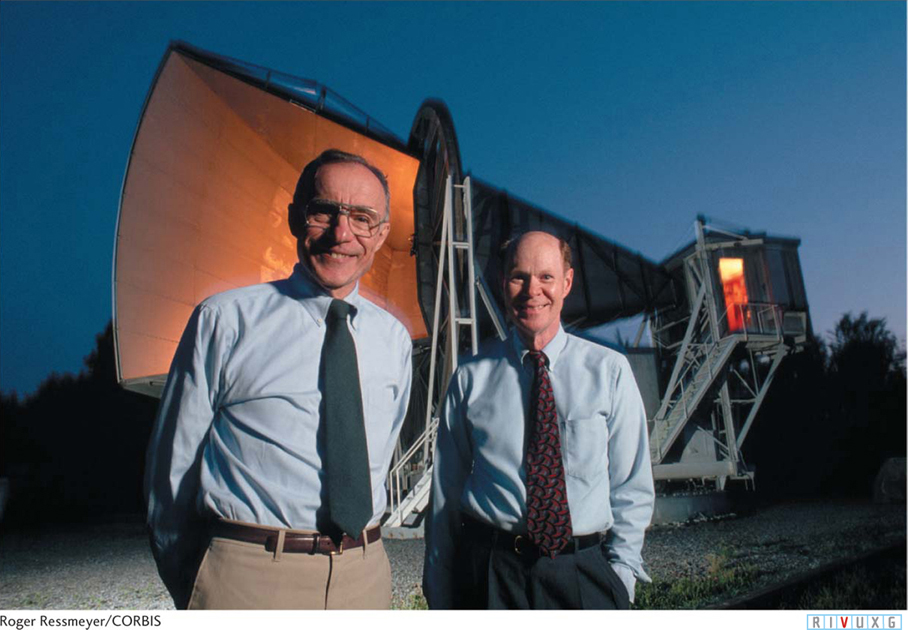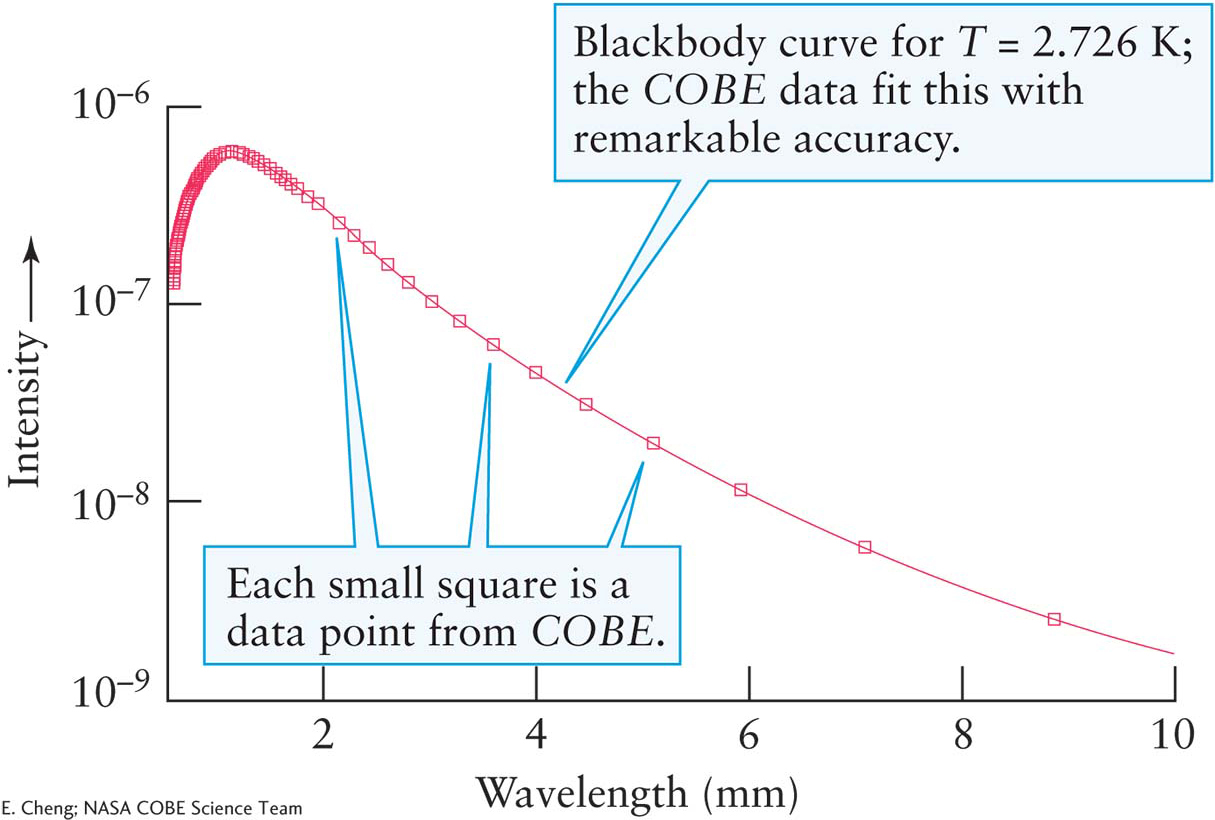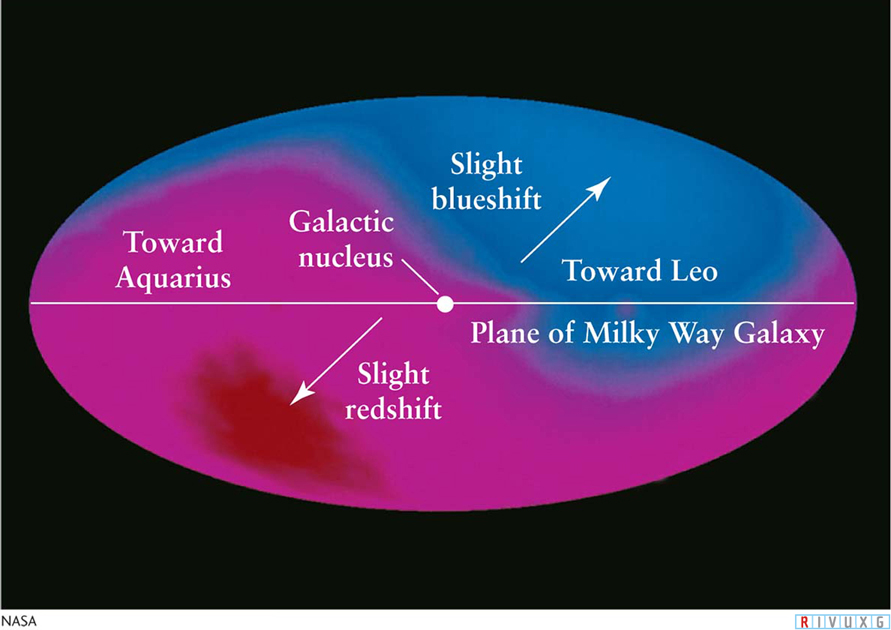THE BIG BANG
Focus Question 14-2
If the universe were twice as old as it is now, how would the Hubble constant compare to the value it has today?

 In 1927, the Belgian astrophysicist and Catholic priest Georges Lemaître proposed that, as a consequence of the equations of Einstein’s theory of general relativity, the universe is expanding. Using Hubble’s subsequent observations of an expanding universe, Lemaître logically concluded that the superclusters must have expanded from a much smaller volume. He proposed that the universe began as an extraordinarily hot and dense primordial atom of energy. Just as energy created in an explosion causes debris to expand outward, the primordial energy created at the beginning of time caused the universe to expand. This initial event is now called the Big Bang. Space and time (that is, spacetime; see Section 12-11) did not exist before that moment. Rather than expanding into preexisting spacetime, the Big Bang explosion created spacetime, and that spacetime (in which we live) has been expanding ever since. The Big Bang led to the formation of all spacetime, matter, and energy. As noted earlier in this chapter, science does not yet have an explanation for why the Big Bang occurred.
In 1927, the Belgian astrophysicist and Catholic priest Georges Lemaître proposed that, as a consequence of the equations of Einstein’s theory of general relativity, the universe is expanding. Using Hubble’s subsequent observations of an expanding universe, Lemaître logically concluded that the superclusters must have expanded from a much smaller volume. He proposed that the universe began as an extraordinarily hot and dense primordial atom of energy. Just as energy created in an explosion causes debris to expand outward, the primordial energy created at the beginning of time caused the universe to expand. This initial event is now called the Big Bang. Space and time (that is, spacetime; see Section 12-11) did not exist before that moment. Rather than expanding into preexisting spacetime, the Big Bang explosion created spacetime, and that spacetime (in which we live) has been expanding ever since. The Big Bang led to the formation of all spacetime, matter, and energy. As noted earlier in this chapter, science does not yet have an explanation for why the Big Bang occurred.
Shortly after World War II, the astrophysicists Ralph Alpher and George Gamow proposed that a fraction of a second after the Big Bang, the universe was an incredibly hot blackbody—in excess of 1032 K. As heat is a measure of how many photons there are and how energetic they are, the early universe must therefore have been filled with intensely high-energy electromagnetic radiation. As the universe expanded, the cosmological redshift stretched these gamma rays to longer and longer wavelengths so that most of the photons left over from this event are now radio waves. Recall from Section 3-3 that photon energies decrease with increasing wavelength. Because the early photons are being redshifted, the energy they each have is decreasing. This energy is measured as heat, so the universe is cooling off as it expands.
14-4 Remnants of the Big Bang have been detected
Calculations indicated that if the universe began with a hot Big Bang, the remnants of that energy should still fill all space today, giving the entire universe a temperature only a few kelvins above absolute zero. This radiation is called the cosmic microwave background because the peak of its blackbody spectrum should lie in the microwave part of the radio spectrum. In the early 1960s, Robert Dicke, P. J. E. “Jim” Peebles, David Wilkinson, and their colleagues at Princeton University began designing a microwave radio telescope to detect it. Meanwhile, just a few miles from Princeton, two physicists had already detected the cosmic background radiation. Arno Penzias and Robert Wilson of Bell Laboratories were working on a new horn antenna designed to relay telephone calls to Earth-orbiting communications satellites (Figure 14-2). However, Penzias and Wilson were mystified. No matter where in the sky they pointed their antenna, they detected a faint background noise. All efforts to eliminate this background noise failed, even the careful removal of static noise-generating pigeon droppings from the antenna.

Figure 14-2  Bell Labs Horn Antenna This Bell Laboratories horn antenna at Holmdel, New Jersey, was used by Arno Penzias (right) and Robert Wilson in 1965 to detect the cosmic microwave background. This discovery earned them the Nobel prize in 1978.
Bell Labs Horn Antenna This Bell Laboratories horn antenna at Holmdel, New Jersey, was used by Arno Penzias (right) and Robert Wilson in 1965 to detect the cosmic microwave background. This discovery earned them the Nobel prize in 1978.
Thanks to a colleague, they learned of the then-theoretical cosmic microwave background and the work of Dicke, Peebles, and Wilkinson in trying to locate it. Communicating with the Princeton astronomers, Penzias and Wilson presented their finding and thus were able to claim the first detection—their annoying noise was, in fact, the remnant energy of the Big Bang. The cosmic microwave background is required by the Big Bang theory but is neither required nor predicted by any other competing cosmological theory. Detection of the cosmic microwave background is the principal reason why the Big Bang is accepted by astronomers as the correct cosmological theory.
Precise measurements of the cosmic microwave background were first made by the Cosmic Background Explorer (COBE) satellite, which operated between 1989 and 1994. The radiation has since been measured more precisely by other equipment, such as the Wilkinson Microwave Anisotropy Probe (WMAP) and the balloon-carried BOOMERANG (Figure 14-3). The data taken by COBE and shown in Figure 14-4 reveal that, as predicted, this ancient radiation has the spectrum of a blackbody with a temperature of approximately 2.73 K (referred to as the 3-degree background radiation). The observations by COBE earned the 2006 Nobel Prize in Physics for astrophysicists John C. Mather and George F. Smoot.

Figure 14-3  In Search of Primordial Photons (a) The Wilkinson Microwave Anisotropy Probe (WMAP) satellite, launched in 2001, improved upon the measurements of the spectrum and angular distribution of the cosmic microwave background taken by the COBE satellite. (b) The balloon-carried telescope BOOMERANG orbited above Antarctica for 10 days, collecting data used to resolve the cosmic microwave background, with 10 times higher resolution than that of COBE. All of these experiments found local temperature variations across the sky but no overall deviation from a blackbody spectrum.
In Search of Primordial Photons (a) The Wilkinson Microwave Anisotropy Probe (WMAP) satellite, launched in 2001, improved upon the measurements of the spectrum and angular distribution of the cosmic microwave background taken by the COBE satellite. (b) The balloon-carried telescope BOOMERANG orbited above Antarctica for 10 days, collecting data used to resolve the cosmic microwave background, with 10 times higher resolution than that of COBE. All of these experiments found local temperature variations across the sky but no overall deviation from a blackbody spectrum.

Figure 14-4 Spectrum of the Cosmic Microwave Background The little squares on this graph are COBE’s measurements of the brightness of the cosmic microwave background plotted against wavelength. To a remarkably high degree of accuracy, the data fall along a blackbody curve for 2.73 K. The peak of the curve is at a wavelength of 1.1 mm, in accordance with Wien’s law.
Focus Question 14-3
What other objects that we have studied in this book have (nearly) blackbody spectra?
The photons of the 3-degree background radiation are not the only remnants of the Big Bang that astronomers have found. In 2008, neutrinos created along with the photons in the Big Bang were indirectly observed by WMAP. (Recall from Section 9-7 that neutrinos are also created today in the nuclear fusion occurring in the Sun and other stars.) The discovery of these cosmic neutrinos was made by comparing the predicted effects of those neutrinos on the young universe with observations of the earliest observable remnants of the Big Bang, about which we will have more to say shortly. The theory of these neutrinos and the observations of their predicted effects agree to high precision. The numbers of neutrinos in the cosmic neutrino background is impressive: Several million of them pass through your body every second. There are similar numbers of neutrinos in similar volumes of space everywhere in the universe.
Insight Into Science
Consider Plausible Alternatives Until They Are Shown to Be Inconsistent with Observations Sir Fred Hoyle, who aptly named the Big Bang in 1949, was one of the very few astrophysicists who never believed that it occurred. Hoyle, Herman Bondi, and Thomas Gold proposed the steady-state theory in which the universe has existed forever, is continuously expanding, and, as it expands, new matter is created that takes the place of the receding matter. Where this new matter might come from is unknown, but the laws of physics do not necessarily exclude its creation. Today, astronomers accept the Big Bang theory rather than the steady-state theory because a cosmic microwave background is predicted to exist by the Big Bang theory but not by the steady-state theory.
14-5 The universe has two symmetries—isotropy and homogeneity

Figure 14-5  Microwave Sky This map of the microwave sky was produced from data taken by instruments on board COBE. The galactic center is in the middle of the map, and the plane of the Milky Way runs horizontally across the map. Color indicates Doppler shift and temperature: Blue is where the microwave background is blueshifted and appears warmer, while red is where it is redshifted and appears cooler. This Doppler shift across the sky is caused by Earth’s motion through the microwave background. The resulting variation in background temperature is quite small, only 0.0033 K above the average radiation temperature of 2.726 K (which we have rounded to 2.73 K in the text).
Microwave Sky This map of the microwave sky was produced from data taken by instruments on board COBE. The galactic center is in the middle of the map, and the plane of the Milky Way runs horizontally across the map. Color indicates Doppler shift and temperature: Blue is where the microwave background is blueshifted and appears warmer, while red is where it is redshifted and appears cooler. This Doppler shift across the sky is caused by Earth’s motion through the microwave background. The resulting variation in background temperature is quite small, only 0.0033 K above the average radiation temperature of 2.726 K (which we have rounded to 2.73 K in the text).
Focus Question 14-4
What object other than Earth could meaningfully have been used at the center of Figure 14-6?

Figure 14-6 Our Motion Through the Microwave Background Because of the Doppler effect, we detect shorter wavelengths in the microwave background and a higher temperature of radiation in that part of the sky toward which we are moving. This part of the sky is the area shown in blue in Figure 14-5. In the opposite part of the sky, shown in red in Figure 14-5, the microwave radiation has longer wavelengths and a cooler temperature.
Observations show that the cosmic microwave background is almost perfectly isotropic: Its intensity is nearly the same in every direction in the sky. Indeed, if you could look at the cosmic microwave background from all directions in the entire universe with the naked eye, it would appear as uniform as a well-painted wall. However, when extremely high-resolution measurements are made, tiny differences in the temperature of the universe are observed in different directions. One difference is caused by our motion through the cosmic microwave background. Figure 14-5 shows a map of the microwave sky. It is very, very slightly warmer than average in the direction of the constellation Leo and slightly cooler in the opposite direction, toward Aquarius. The observed temperature differences shown in Figure 14-5 mean that the solar system is moving toward Leo at a speed of 390 km/s. These observations can be understood as follows: As we move toward Leo, our motion through the cosmic microwave background radiation creates a normal Doppler shift that causes photons from that direction to appear to have shorter wavelengths—radiation from the direction of Leo is blueshifted, whereas radiation from the opposite direction, Aquarius, is redshifted because we are moving away from that region (Figure 14-6). Furthermore, a photon’s wavelength determines its energy (see Section 3-3). The energy of the photons then determines the temperature that we measure for that part of the sky. Observing slightly shorter-wavelength photons in the direction of Leo means that space in that direction appears slightly warmer, because of our motion, than does space in other directions.
As noted in Section 13-14, the Milky Way and the rest of our Local Cluster are part of the Laniakea supercluster. Taking into account the known velocity of the Sun around the center of our Galaxy, astronomers calculate that the entire Milky Way Galaxy is moving relative to the cosmic microwave background at 600 km/s—some 1.3 million mi/h—in the general direction of the Virgo cluster. The gravitational attraction of four nearby clusters of galaxies, most significantly the Great Attractor, and an enormous supercluster called the Shapley concentration, located behind the Virgo cluster from our perspective, is believed to be pulling us in that direction. Subtracting the motions of Earth, the Sun, the Milky Way, and the Local Group (of galaxies) with respect to the microwave background, the average intensity of radiation is found to be the same in all directions (that is, isotropic) to about 1 part in 100,000.
Although the existence of the cosmic background radiation provides compelling support for the Big Bang theory, its near-isotropy was, until recently, a major problem. The issue was that the original Big Bang theory did not require space to be isotropic—after accounting for Earth’s motion through the cosmos, the temperature in one direction could have been many degrees different than the temperature in any other direction, but it is not.
Isotropy is not limited to the blackbody radiation observed throughout the universe. It is also found on sufficiently large scales when exploring the numbers of galaxies in different directions. Astronomers have counted the numbers of galaxies at different distances from us and in a variety of directions. The number of galaxies stays roughly constant with respect to both distance and direction, allowing, as we saw in Section 13-14, for the distribution of most galaxies on the boundaries of sponge-shaped regions or bubbles throughout the universe. Because of this uniformity with distance, we say that the universe is also homogeneous. Isotropy and homogeneity must be explained by any viable theory of cosmology, such as the Big Bang.
The need to explain isotropy and homogeneity, among other things, has led to numerous refinements in the Big Bang theory. As a result, this theory now provides an accurate scenario for the evolution of the universe from a tiny fraction of a second after it formed and onward.

 In 1927, the Belgian astrophysicist and Catholic priest Georges Lemaître proposed that, as a consequence of the equations of Einstein’s theory of general relativity, the universe is expanding. Using Hubble’s subsequent observations of an expanding universe, Lemaître logically concluded that the superclusters must have expanded from a much smaller volume. He proposed that the universe began as an extraordinarily hot and dense primordial atom of energy. Just as energy created in an explosion causes debris to expand outward, the primordial energy created at the beginning of time caused the universe to expand. This initial event is now called the Big Bang. Space and time (that is, spacetime; see Section 12-
In 1927, the Belgian astrophysicist and Catholic priest Georges Lemaître proposed that, as a consequence of the equations of Einstein’s theory of general relativity, the universe is expanding. Using Hubble’s subsequent observations of an expanding universe, Lemaître logically concluded that the superclusters must have expanded from a much smaller volume. He proposed that the universe began as an extraordinarily hot and dense primordial atom of energy. Just as energy created in an explosion causes debris to expand outward, the primordial energy created at the beginning of time caused the universe to expand. This initial event is now called the Big Bang. Space and time (that is, spacetime; see Section 12-




 Bell Labs Horn Antenna This Bell Laboratories horn antenna at Holmdel, New Jersey, was used by Arno Penzias (right) and Robert Wilson in 1965 to detect the cosmic microwave background. This discovery earned them the Nobel prize in 1978.
Bell Labs Horn Antenna This Bell Laboratories horn antenna at Holmdel, New Jersey, was used by Arno Penzias (right) and Robert Wilson in 1965 to detect the cosmic microwave background. This discovery earned them the Nobel prize in 1978. Microwave Sky This map of the microwave sky was produced from data taken by instruments on board COBE. The galactic center is in the middle of the map, and the plane of the Milky Way runs horizontally across the map. Color indicates Doppler shift and temperature: Blue is where the microwave background is blueshifted and appears warmer, while red is where it is redshifted and appears cooler. This Doppler shift across the sky is caused by Earth’s motion through the microwave background. The resulting variation in background temperature is quite small, only 0.0033 K above the average radiation temperature of 2.726 K (which we have rounded to 2.73 K in the text).
Microwave Sky This map of the microwave sky was produced from data taken by instruments on board COBE. The galactic center is in the middle of the map, and the plane of the Milky Way runs horizontally across the map. Color indicates Doppler shift and temperature: Blue is where the microwave background is blueshifted and appears warmer, while red is where it is redshifted and appears cooler. This Doppler shift across the sky is caused by Earth’s motion through the microwave background. The resulting variation in background temperature is quite small, only 0.0033 K above the average radiation temperature of 2.726 K (which we have rounded to 2.73 K in the text).